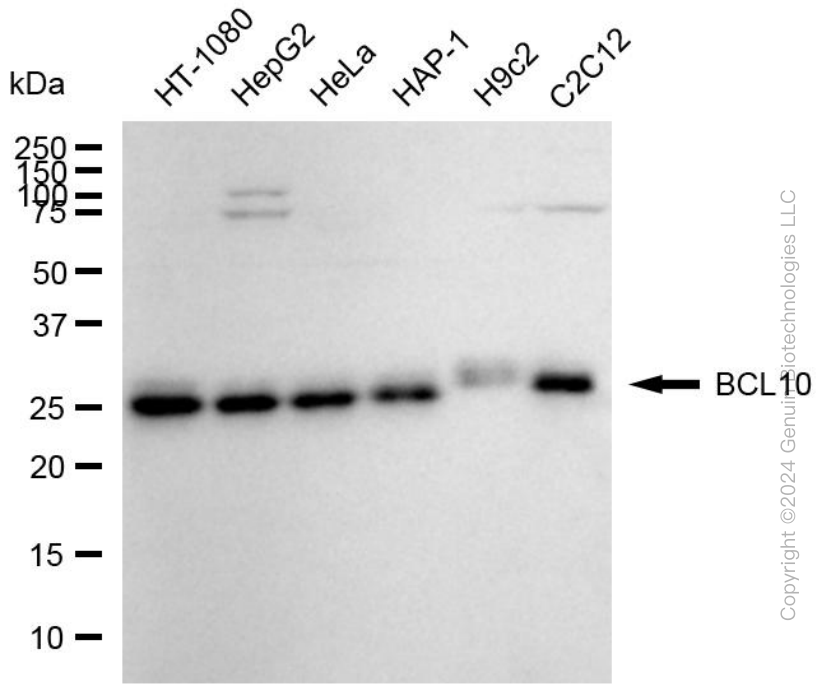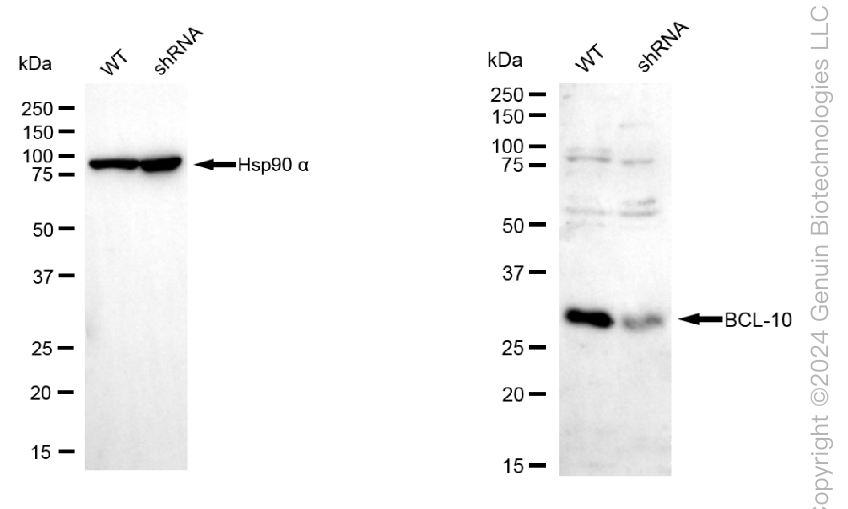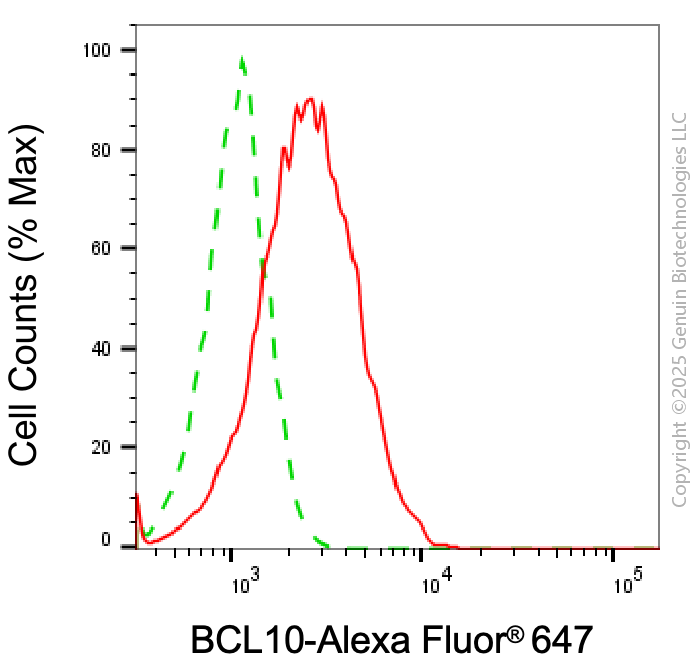KD-Validated Anti-BCL10 Mouse Monoclonal Antibody
Mouse monoclonal antibody
- SPECIFICATION
- CITATIONS
- PROTOCOLS
- BACKGROUND

Application
| WB, FC, ICC |
|---|---|
| Primary Accession | O95999 |
| Reactivity | Rat, Human, Mouse |
| Clonality | Monoclonal |
| Isotype | Mouse IgG1 kappa |
| Clone Names | 24GB2925 |
| Calculated MW | Predicted, 26 kDa, observed, 28 kDa |
| Gene Name | BCL10 |
| Aliases | BCL10; BCL10 Immune Signaling Adaptor; CIPER; C-E10; ME10; CLAP; CARMEN; CED-3/ICH-1 Prodomain Homologous E10-Like Regulator; Mammalian CARD-Containing Adapter Molecule E10; CARD-Containing Molecule Enhancing NF-Kappa-B; Caspase-Recruiting Domain-Containing Protein; CARD-Containing Apoptotic Signaling Protein; CARD Containing Molecule Enhancing NF-KB; CARD-Containing Proapoptotic Protein; CARD-Like Apoptotic Protein; B-Cell Lymphoma/Leukemia 10; Cellular Homolog Of VCARMEN; B Cell CLL/Lymphoma 10; Cellular-E10; CCARMEN; HCLAP; BCL10, Immune Signaling Adaptor; B-Cell CLL/Lymphoma 10; Bcl-10; IMD37 |
| Immunogen | Recombinant protein of human BCL10 |
| Gene ID | 8915 |
|---|---|
| Other Names | B-cell lymphoma/leukemia 10, B-cell CLL/lymphoma 10, Bcl-10, CARD-containing molecule enhancing NF-kappa-B, CARD-like apoptotic protein, hCLAP, CED-3/ICH-1 prodomain homologous E10-like regulator, CIPER, Cellular homolog of vCARMEN, cCARMEN, Cellular-E10, c-E10, Mammalian CARD-containing adapter molecule E10, mE10, BCL10 {ECO:0000303|PubMed:9989495, ECO:0000312|HGNC:HGNC:989} |
| Name | BCL10 {ECO:0000303|PubMed:9989495, ECO:0000312|HGNC:HGNC:989} |
|---|---|
| Function | Plays a key role in both adaptive and innate immune signaling by bridging CARD domain-containing proteins to immune activation (PubMed:10187770, PubMed:10364242, PubMed:10400625, PubMed:24074955, PubMed:25365219). Acts by channeling adaptive and innate immune signaling downstream of CARD domain-containing proteins CARD9, CARD11 and CARD14 to activate NF-kappa-B and MAP kinase p38 (MAPK11, MAPK12, MAPK13 and/or MAPK14) pathways which stimulate expression of genes encoding pro-inflammatory cytokines and chemokines (PubMed:24074955). Recruited by activated CARD domain-containing proteins: homooligomerized CARD domain-containing proteins form a nucleating helical template that recruits BCL10 via CARD-CARD interaction, thereby promoting polymerization of BCL10, subsequent recruitment of MALT1 and formation of a CBM complex (PubMed:24074955). This leads to activation of NF-kappa-B and MAP kinase p38 (MAPK11, MAPK12, MAPK13 and/or MAPK14) pathways which stimulate expression of genes encoding pro-inflammatory cytokines and chemokines (PubMed:18287044, PubMed:24074955, PubMed:27777308). Activated by CARD9 downstream of C-type lectin receptors; CARD9-mediated signals are essential for antifungal immunity (PubMed:26488816). Activated by CARD11 downstream of T-cell receptor (TCR) and B-cell receptor (BCR) (PubMed:18264101, PubMed:18287044, PubMed:24074955, PubMed:27777308). Promotes apoptosis, pro-caspase-9 maturation and activation of NF-kappa-B via NIK and IKK (PubMed:10187815). |
| Cellular Location | Cytoplasm, perinuclear region. Membrane raft. Note=Appears to have a perinuclear, compact and filamentous pattern of expression. Also found in the nucleus of several types of tumor cells. Colocalized with DPP4 in membrane rafts. |
| Tissue Location | Ubiquitous.. |

Thousands of laboratories across the world have published research that depended on the performance of antibodies from Abcepta to advance their research. Check out links to articles that cite our products in major peer-reviewed journals, organized by research category.
info@abcepta.com, and receive a free "I Love Antibodies" mug.
Provided below are standard protocols that you may find useful for product applications.
If you have used an Abcepta product and would like to share how it has performed, please click on the "Submit Review" button and provide the requested information. Our staff will examine and post your review and contact you if needed.
If you have any additional inquiries please email technical services at tech@abcepta.com.














 Foundational characteristics of cancer include proliferation, angiogenesis, migration, evasion of apoptosis, and cellular immortality. Find key markers for these cellular processes and antibodies to detect them.
Foundational characteristics of cancer include proliferation, angiogenesis, migration, evasion of apoptosis, and cellular immortality. Find key markers for these cellular processes and antibodies to detect them. The SUMOplot™ Analysis Program predicts and scores sumoylation sites in your protein. SUMOylation is a post-translational modification involved in various cellular processes, such as nuclear-cytosolic transport, transcriptional regulation, apoptosis, protein stability, response to stress, and progression through the cell cycle.
The SUMOplot™ Analysis Program predicts and scores sumoylation sites in your protein. SUMOylation is a post-translational modification involved in various cellular processes, such as nuclear-cytosolic transport, transcriptional regulation, apoptosis, protein stability, response to stress, and progression through the cell cycle. The Autophagy Receptor Motif Plotter predicts and scores autophagy receptor binding sites in your protein. Identifying proteins connected to this pathway is critical to understanding the role of autophagy in physiological as well as pathological processes such as development, differentiation, neurodegenerative diseases, stress, infection, and cancer.
The Autophagy Receptor Motif Plotter predicts and scores autophagy receptor binding sites in your protein. Identifying proteins connected to this pathway is critical to understanding the role of autophagy in physiological as well as pathological processes such as development, differentiation, neurodegenerative diseases, stress, infection, and cancer.





